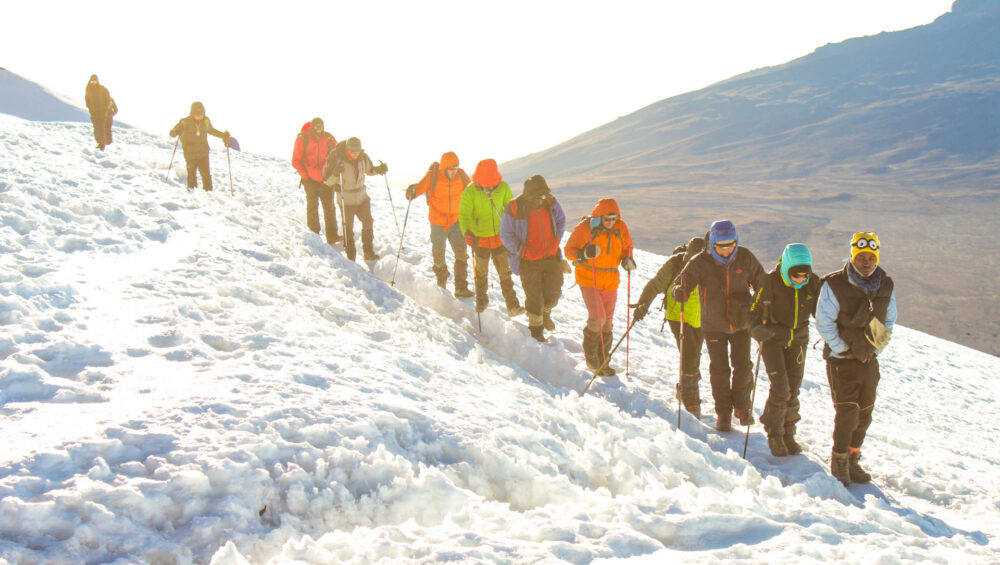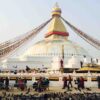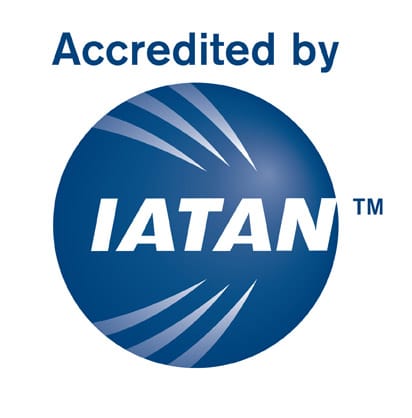HOW LONG DOES IT TAKE TO CLIMB MOUNT KILIMANJARO?
Travelers planning to climb Mount Kilimanjaro frequently ask how long does it take to climb Mount Kilimanjaro? It takes about five to nine days on the longer routes to reach Mount Kilimanjaro Summit Uhuru peak and descend to the finishing point. The more days you spend on the mountain acclimatizing, the better your chances of reaching the top. Trekkers who spend only five days have the lowest summit success rate.
Trekkers who spend eight or nine days have a much better chance of summiting. Factors affecting how long it takes to climb Kilimanjaro
Kilimanjaro is a “walk-up” mountain, meaning there is no technical climbing involved. How long it takes to reach the summit is largely dictated by how well you are able to acclimate to the lack of oxygen at high altitudes.
Acclimatization
The main reason why climbers fail to reach the summit of Kilimanjaro is simply that they have not acclimatized to the altitude.
How badly do you want to get to the summit? If you’re serious about completing the climb, the main factor standing in your way is acclimatization.
The good news is that going slow and taking your time allows your body to gradually adapt to the reduced oxygen.
The more days you spend on the mountain acclimatizing, the better your chances of reaching the top. Trekkers who spend only five days on Kilimanjaro have the lowest success rate, while those who spend 8 or 9 days have a much better chance of standing on the Roof of Africa.
The Wilderness Medical Society Practice Guidelines for the Prevention of Acute Altitude Illness says that controlling the rate of ascent, in terms of the number of meters gained each day is a “highly effective means of preventing altitude illness.”
A slow and steady ascent gives your body time to adjust to the altitude, and while physical fitness does not seem to have an effect on how well you acclimatize, you’ll build in enough time for rest and recovery after the day’s hiking.
It’s difficult to get up-to-date data from the Kilimanjaro National Park, but in 2006 estimates of the success rate based on the number of days spent on the mountain were clear. At that time:
- 27% of those who opted for the five-day trek made it to the summit.
- 85% of trekkers who spent eight days on their climb were successful.
Those numbers have no doubt improved since then thanks to better guides, improved gear, and a better understanding of how to successfully hike the trail. But they give you an indication of the importance of taking your time on the mountain.
Being very fit does not correlate with an increased ability to acclimatize. Being physically fit will make the hiking easier, as well as reduce fatigue and stress, but it won’t help you acclimate.
According to Dr. Hackett from the Institute for Altitude Medicine, says physical fitness will give you no protection from altitude sickness. Sometimes, many young, fit people will push through the discomfort, ignoring important symptoms.
How long does it take to climb Mount Kilimanjaro on each route?
There are a total of six different routes you can use to climb Mount Kilimanjaro.
The shortest possible way to the summit is by the Marangu or the Umbwe Route. These routes can be completed in 5 days (but we don’t recommend it for most hikers).
The longer treks, Lemosho, Machame, Rongai, or the Northern Circuit route take 6-10 days.
The main reason you’d want to take a longer route is to give your body time to acclimatize to the altitude, but there are other considerations as well.
Unless you are very fit, covering the same amount of ground in a shorter time frame can increase your chances of fatigue and injury – and compromise your enjoyment of the environment.
Climbing Kilimanjaro recommends Trekkers who have a flexible schedule to consider a longer route or build in one or two acclimatization days and have an easier time reaching the summit.
Each route is varied in the duration of the mountain, the types of accommodation, the level of difficulty, the type of scenery, and other factors.
The table below lists each route, sorted by the number of days usually taken on each route.
| Route | Number of Days | Route Length |
|---|---|---|
| Marangu Route | 5 | 64 kilometers (40 mi) |
| Umbwe Route | 6 | 37 kilometers (23 mi) |
| Rongai Route | 6 or 7 | 65 kilometers (23 mi) |
| Machame Route | 6 or 7 | 49 kilometers (30 mi) |
| Lemosho Route | 7,8 or 9 | 66 kilometers (35 mi) |
| Northern Circuit | 8 or 9 | 66 kilometers (35 mi) |
You can climb Kilimanjaro in five or six days, but is it worth the risk?
You can definitely climb Kilimanjaro in five or six days. Most clients we’ve spoken to are attracted to the shorter routes for these reasons:
- Cost savings
- Lack of vacation time
- Don’t want to hike for so many days
In all of Climbing Kilimanjaro’s combined years of experience as mountain guides and trek organizers, we encourage a longer, steadier climb as it is safer, and increases our clients’ summit success rate dramatically.
Additionally, giving yourself time to enjoy the unique mountain environment with adequate rest and recovery will make for a much more enjoyable experience.
These are the questions we ask and encourage you to ask yourself:
- How would you feel if you scheduled a route with the minimum days only to have to turn back on day three because the rate of ascent was too quick and you did not have time to acclimate?
- Wouldn’t you rather add a couple of days to your trip to give yourself a better chance of summiting and to make it easier on your body?
- Were the “savings” you got for not taking additional days worth the cost of cutting your climb short, not making it to the summit, or worse still, putting your health at risk?
When is it a good idea to opt for a shorter Kilimanjaro climb?
- If you’ve recently been to a high altitude. If you’ve climbed Mt. Meru or Mt. Kenya successfully, for example, you will have an element of pre-acclimatization and can get away with a shorter route.
- If you’re a very experienced climber and have been to extreme altitudes before (>18,000ft) and are confident of your ability to acclimatize.
It’s an undeniable fact that longer routes increase summit success rates.
How long does it take to descend Kilimanjaro?
It takes around two days to descend Kilimanjaro from the Uhuru Peak Summit to the Finish point. The descent can take up to five hours to reach the camp for overnight, and four to six hours the following day depending on the route and trekker’s experience.
Quick Facts: Fastest times to the Summit of Mount Kilimanjaro by elite athletes
Current record holder:
Karl Egloff, a Swiss climber, made it in 4 hours, 56 minutes. He’s gone on to break records on Aconcagua, Cotopaxi, and others. You can read more about his intense training and pre-acclimatization program here.
Other notable times:
- Fastest woman Kristina Schoo Madsen (from Denmark): 6 hours and 52 minutes via the Mweka route
- Simon Mtuy from Tanzania holds the record for the fastest unaided attempt. He carried all his own gear, including food and water, in 9 hours and 19 minutes on the Umbwe route.
- Kilian Jornet, the previous record-holder, made it in 7 hours, 14 minutes.
How long will it take YOU?
Climbing Kilimanjaro is a once-in-a-lifetime experience: you’ve trained for it and paid for it, so don’t compromise your safety or chance of success.
Got questions? Send us an email or hit the live chat button.






